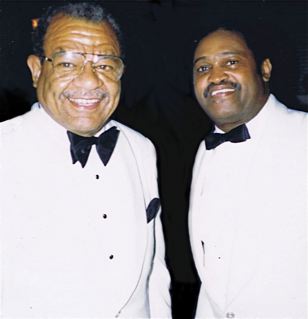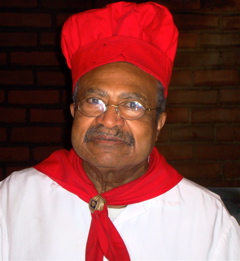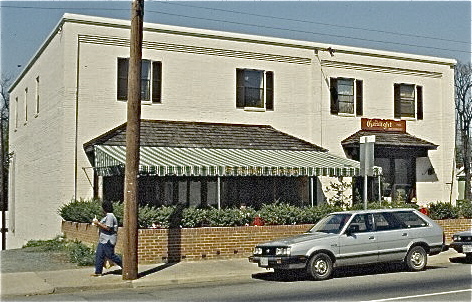 Reminiscence Charlottesville's Gaslight Restaurant By Rey Barry
This Gaslight had nothing at all to do with the New York restaurant bearing that name. Charlottesville's Gaslight was the concept of John Marshall Tuck, a man blessed with serious ancestry and a genial, powerful personality.
We make no claim to having an inside view of the Gaslight. Capitalizing on a 1961 fire that destroyed a popular steak house and left the best wait staff in town without jobs, John created a restaurant that was - all in one room - a steak house, beer hall, oyster bar, pop-art museum, pub, employment agency, jazz joint, and folk singer's coffeehouse.
Few ever knew what John really wanted was to run "21, the NYC speakeasy that became a legendary dining emporium. Through his adult life John carried in his pocket a match book from "21" [the quotes are part of the name] to keep in touch with his dream.
For most people, what it takes to reach greatness is a dream to be doing something else. It certainly worked for Tuck. And for us. In its prime the Gaslight was Charlottesville's "21." It even attracted big names. In one of his ads, John ran this list of Honored Gaslight Guests: Muhammed Ali - The Boston Philharmonic - Frank Capra - Carlos Montoya - Paul Simon - Art Garfunkle - Bob Dylan - Jerry Falwell - Dionne Warwick - Diana Ross - Alan Alda - Susan Ford - Lady Bird Johnson - Tom Wolfe - Yevgeny Yevtushenko - Ethel Kennedy - John Anderson - Sunny Jurgenson - Eleanor McGovern - The Supremes. He could have added Maria Rasputin, the legendary Russian monk's only legitimate child. I took her there for dinner in 1968 as described elsewhere on this site, the page devoted to Anastasia
The Gaslight opened in a lean-to addition on the east side of the Albemarle Hotel on West Main Street. In pre-urban renewal days the neighborhood was seedy. 1970s photo courtesy of John Shepherd Photography. The Southern Railway station was up the street between the Gaslight and the University of Virginia. The Vinegar Hill black business district lay down the street separating the light from downtown. The romance of seedy surroundings helped the Gaslight attract crowds from town and gown, and also brought in the fox hunting lushes from the county. The ambience appealed to all.
The Gaslight was where Bob Zimmerman, trying out the name Bob Dylan, sang for the change you threw in his hat, and Joan Baez, a national headliner, sang the same night for free because it was fun. They were both in town to pick the brains and go through the song files of Appalachian folklorist and song collector Paul Clayton, a frequent Gaslight entertainer until John banned him for too many randy gay jokes. Paul Clayton
They sang to a room where bicycles hung from the ceiling and a sinister painting of Nero enjoying Rome burning hung on the wall. In 1993 on the night before the Gaslight's memorabilia was sold, Nero was set afire and destroyed by an owner it frightened. Other walls held the head of an enormous wild boar and equally enormous chalk pastel blow-ups of Playboy centerfolds.
Plus hundreds of other things. Customers with interesting relics they might today sell on eBay they passed to John who found space to display them. Not infrequently there were displays in the lounges. The ladies' room was purple, the men's featured a trough instead of urinals. But things did not always go as expected. There was the cool late September evening in 1967 when a tenant at Dr. Sidney Britton's Windemere Farm brought John a huge wasps nest on a tree branch. It went up on the wall. By 10 o'clock the staff and the customers became acutely aware that wasps do not vacate nests but only hibernate, emerging when it's warm. The Gaslight was warm. By 10:15 it was closed to all but the exterminator. Imagine that. Or the day John was brought a Bausch & Lomb Combined Balopticon [early slide projector] and scores of hand-painted glass slides. He liked it enough to build a platform beneath the ceiling for this, erect a screen in a corner of the room, and several times an hour climb a ladder to change slides. All was fine for months until the owner of the projector, who happened to also own the Gaslight building and much of the town, chanced to come in and see it. Seems the projector and slides disappeared from a storage shed at Neve Hall, a stone rectory he had bought. Imagine that. The regular and irregular customers at the Gaslight included most every character in town and every visitor with a business idea. One night a gent came in who quietly offered one white male employee after another the opportunity to be the deeded owner of a Charlottesville cathouse he would buy for him, and provide the girls. There were no takers, maybe because Jim Abbe wasn't in that night. Late one afternoon Len and Flovie Thompson came by "to see this place we heard so much about." They were there until closing. The Thompsons ran the Criterion Pub in Cambridge, England. It seems UVa students going on to Brit schools talked long into the night about Gaslight doings. Perhaps they told of the night when writer and guitarist Toby Thompson, after being tossed out by Tuck for rowdiness, returned wearing a skirt, blouse, and wig borrowed from the wife of his med school friend, Sandy Rock. Tuck didn't recognize him but one waiter called him "the ugliest woman I've EVER seen."
This is Toby spending an afternoon playing guitar duets with writer James Dickey [RIP 1/19/1997], also a superb guitarist. Within a year of this Dickey wrote his famous "Dueling Banjos" scene for his book and movie Deliverance which lends poignancy to the photo. Thompson later published entertaining journals one of which, the 1971 Positively Main Street, has become a sought-after underground classic. It traces Bob Dylan's Hibbing, MN, origins. It's not mere reportage; Toby gets personally involved with Dylan's old girlfriend, Echo Star Helstrom, and others who were close to Bob. For more about Toby, see http://www.two-riders.co.uk/toby.html Gaslighters in Cambridge could also have talked about Ginny Canfield [later Taylor, later Todd, later Toms, RIP 12/13/2003] the local leggy blond painter who made a small career out of singing at the Gaslight. Her innocent sincerity set a standard for this saloon society Tuck churned up. Or maybe they talked of the Dancing Bear, a large, docile wino who by 9:30 would be up and dancing, alone, to the sounds of Beau Loving's piano. Beau Baby was unique, a pianist who made every song sound like "Hello Dolly." On weekends a jazz combo came down from DC and blew the roof off. Those nights, when the scratchy "Trooping The Colors" recording of the Coldstream Guards blared out the nightly closing march that all knew meant drink up, some were wise enough to hang back. At midnight or 1 the door was locked, the room had only familiar faces, and jazz continued until dawn, music and libations free for all. The rest of the week, after closing meant putting on Tony Bennett's Columbia album Hometown, My Town [CL 1301] and its lush Ralph Burns arrangements of "Skyscraper Blues" and "I Cover the Waterfront." By the time the last song came up, your mood was set by "All by Myself" or "The Party's Over." Same mood. And always the same record. John Tuck [1929-1983] returned from military service in the mid-50s to enroll as an older undergraduate at the Univ. of Virginia. A pre-occupied student destined to enjoy his deck of cards more than he understood them, still he was often in good standing academically and occasionally so financially. To support himself he was the night manager at the Gallery Court Motel, a 2-story string of bedrooms alongside the Chesapeake & Ohio railway tracks. It's still there, having been burned and rebuilt, now owned by a motel chain. The motel owner then was an occasionally prosperous, mostly retired real estate developer with a younger, vivacious wife who made Christmas decorations sold in upscale big city department stores. This June-November couple and their children were the second fortuitous connection of Tuck's life, the first being his lineage. Among his forebears, so he said, was John Marshall, celebrated Chief Justice of the US Supreme Court from 1801 to 1835.
When decades later the vivacious wife was widowed, Helena [1924-1992] and John had a well-attended faux wedding. An anonymous couple we'll call
When the bar in the basement of a Howard Johnson's restaurant next door to the motel became available, Tuck's friends helped him get the lease to the "Raven Room" and John began his career running something like a restaurant, and dreaming of better. [Aside: All-American football great Joe Palumbo later ran "The Library" restaurant in that building. Uva bought the property and tore down the HoJo's building, Buddy's Restaurant, and the service station, replacing them with, at least temporarily, greenspace. Now back to the Gaslight.] Then during the summer of 1961 there was a devastating fire at The Steak House, a 1st rate beef restaurant and bowling alley near the University. It destroyed the best beef house in town and left the best wait staff without jobs. It never reopened. Kane furniture store was built on the site. John and his mentor rushed into the restaurant vacuum and soon, with friends like Carl Sewell pitching in to help, the "Gaslight Coffee House" opened down the street in a wing attached to one of the city's two remaining downtown hotels. Sewell tells me it was he who painted the ladies room purple, and provided the "Trooping The Colors" recording that, so long as we live, will mean Gaslight! to everyone who ever stayed until closing. That first Gaslight home was a restaurant space that had briefly been a Cooley-Weber restaurant (of University Cafeteria fame) that moved to a fancier location on US 29. Earlier it was the Albemarle Hotel Coffee Shop. These were the final years for the city's 2nd last railway station hotel. Among its very last guests were my late aunt Mimi and cousin Alan stopping by to visit on the way to Mexico. At the front of the room beneath the window, cheffie Louis Steppe [RIP 10/23/1989] (later the chicken frying chef at tourist attraction Michie Tavern) charcoaled the steaks supplied by Mortimer's of Lynchburg, the area's supplier of portion-controlled USDA Choice beef. It wasn't the top quality, grain fed, aged Kansas City beef Nick Reynolds brought in for the Steak House, but it was the best in town for a time, a cut above Nick Strato's Gus's Steak House and (later) Jack Gladwich's Place. In the back behind the dining room John's mentor had his realty office. When the students returned in the fall the Gaslight was an overnight success. There was nothing remotely close to it in central Virginia. Jim Crow was still the rule in restaurants and this was as close to an integrated clientele as there was, aside from Ed Jackson's Bren-Wana nightclub beyond the southern edge of town. Black businessman Ed Jackson [RIP 9/11/2001] opened an integrated jazz club and seafood restaurant in the late 50s. Few came to dine there in the beginning despite excellent fish and good steaks. It caught on thanks in part to Catholics seeking fish on Friday nights, such as WCHV radio engineer Tom Gallagher. Later Tuck often hung out there when he could get away from the Gaslight, but in the early 60s the white saloon crowd hadn't yet discovered the Bren. They discovered the Gaslight.
Jim Doniel was John's manager for a time before he went off as a sea cook;
One night the wait staff went on strike and Robert sided with them in the dispute. Managers can't do that to the boss, and soon the fired Johnson was across the street at the Waffle Shop, open 24/7, cooking short orders on the graveyard shift.
A calamity? The Waffle Shop's owner in partnership with Bart Shaw-Kennedy [RIP 12/6/2005] shortly thereafter opened the upscale Angus Barn [now Aberdeen Barn] and Johnson became the man in charge of preparing the best beef in town. In its early days the Gaslight participated in Charlottesville's annual Apple Festival parade with a float. Through 1964 it was a nighttime parade. In '65 it blossomed into the Dogwood Festival and night parades were over. For much of the Gaslight's life a photo of its 1964 parade float hung on the Gaslight's side wall. This photo.
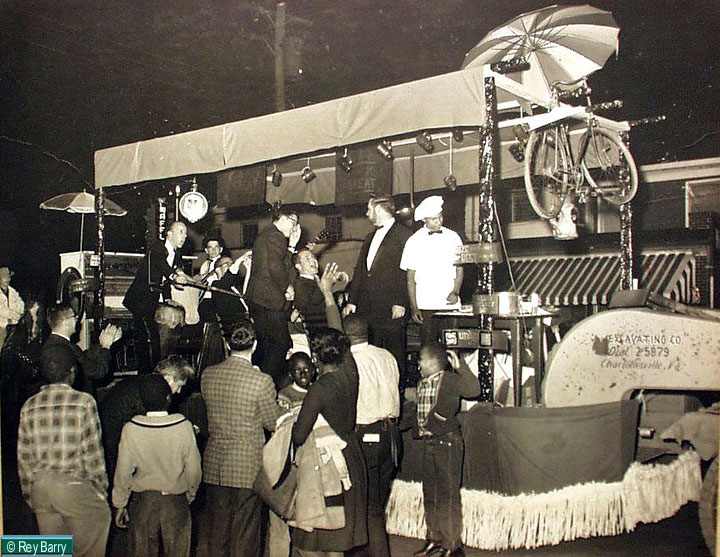
Over the years the Gaslight had good and bad financials. John even opened a branch of the Gaslight in Roanoke, Virginia. It didn't catch on in that backwater. He said he lost $20k on it. John changed the name of his place from "Gaslight Coffee House" to "Gaslight Court Stable Restaurant" in time for the 1967 phonebook. No one but John and Centel noticed. When tastes changed, John moved the Gaslight in 1970 to the Barracks Road Shopping Center, and converted to the upscale "Gaslight Fountain Restaurant" catering to country lushes with yuppie menus and dieter portions. Almost overnight it went from a masculine restaurant to feminine. After 11 years of tedium with that crowd, in 1982 he moved back to West Main to try to rekindle the spark, using the simple name "Gaslight Restaurant." Alas, urban renewal had changed the character of the old seedy neighborhood. Gone was the Vinegar Hill black business district, re-scaled and beginning gentrification. The Gaslight no longer stood out. The contrast was impossible to re-capture. The hotel had been turned into an office building. Its storefront was a wiccan bookstore. The lean-to addition that had been home to the original Gaslight had been torn down for parking. So Tuck secured a renovated, downsized former garage and auto parts store on the west side of the hotel that had been home to  "Whitey" Frazier's API, the city's first computerized auto parts store. [RIP Norman Frazier 2/23/2017] 1976 photo courtesy of "John Shepherd Photography."
This third Gaslight had some of the trappings of the first. A black London taxi that sculptor David Breeden [RIP 9/12/2006] acquired from Mac Woodward was parked on the patio. Mac, a quiet Charlottesville legend, had brought it back along with a Bristol fire engine from his year in Europe. That classic Austin taxi, with this writer driving, once carried half-a-billion dollars of heiresses (that's two) to the Foxfield races. Inside the revamped Gaslight a vintage Victrola was part of the decor. It had been filched years before by tenants of an Ashby Kennen rental house near Albemarle Lake. Alas, the new Gaslight kept the feminine menu of the second Gaslight, and that doomed it for the college and beef crowds. It had its charms but they were too few. For entertainment there was still the nightly piano of Beau Baby and the guest piano appearances of Al (Charles Allison) Dwyer [RIP 2/15/97], a one-time Packard dealer and a class act. Al and his wife, Mary Jane [RIP 3/13/98], had hosted Helena and John's mock wedding at Lagniappe, their farm in Eastham (where the current owners raise llamas.) Times changed, Tuck changed, the 60s joined the roaring 20s as legends, and business didn't succeed. For the umteenth time the Gaslight was struggling financially. Resources tapped again and again were tapped out when word came Tuck's car had plunged off the Skyline Drive down, down into a ravine. John chose his exit in a fiery chariot. After the funeral there occurred one of the great wakes in this town. It was held at Little Mountains Farm, the home of Alden Bigelow [RIP 12/12/2006] and Dorita Tuck Bigelow [RIP 1/13/2010]. John's heirs couldn't agree on the best replacement manager for the Gaslight and compromised on a stepson. They could have done better. In that family it was the females that had the pizazz, vivacity, and drive. The restaurant went downhill and eventually folded. After 30 years the Gaslight was gone. The Gaslight's last telephone book listing is 1994-95. Twelve months after Tuck died a seance for him was held in the Gaslight just after midnight. Over a private dinner beforehand, medium Noreen Renier was offered inside information about John to help things along. She declined the offer. Those who came to the seance prepared with mind altering substances were convinced John was there. One was so overwhelmed that the seance was ended prematurely out of concern for her health. Some shaken fox hunters spent that night in town. -- Rey Barry A couple of ads for the Gaslight in the 60s, and a verbal portrait describing John Do you have pictures of the Gaslight? Please let us add them. And Gaslight memories to share? Whether it's one line or 1000, email them to rey@cstone.net and they will become part of the story.
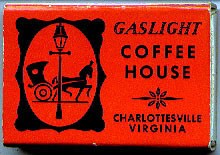
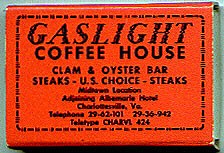
|
|
|
|
Look to the right of the photo above the rear wheel of the bicycle below the umbrella. See the elongated white triangle? That's a paper airplane. It was just launched by the man sitting behind John Tuck's outstretched cane. You can tell by the position of his right arm. It was a thoughtless thing to do in a crowd and John is mad as hell. This was an unplanned, random camera shot. 30 years later my daughter, Apple, wondered what John was upset about and figured it out. |
To return to our Home Page click here
| Click on Charlottesville today for additional background The name Freeware Hall of Fame is Service Marked by Rey Barry (rey at cstone.net) Page last updated March 10, 2020 |

|
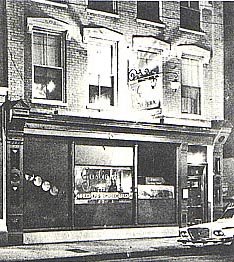

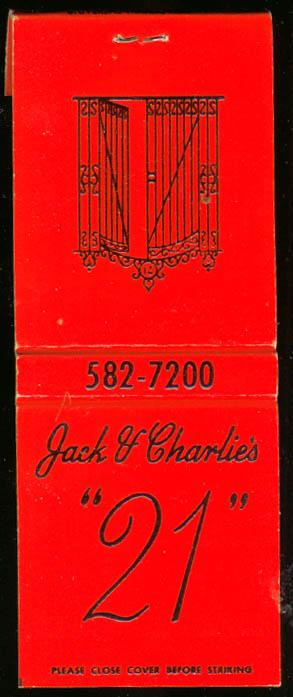
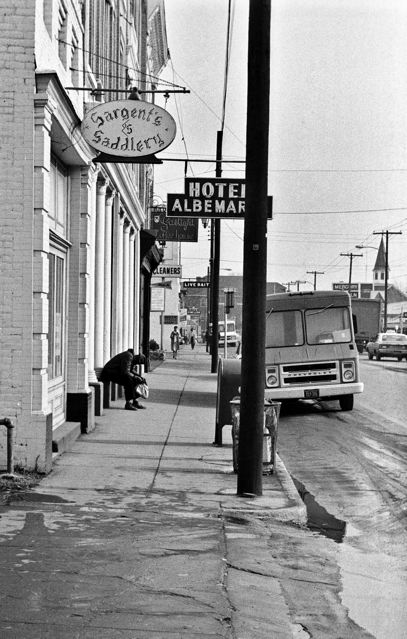
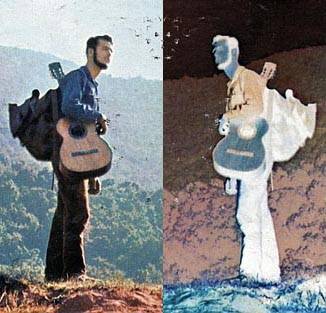
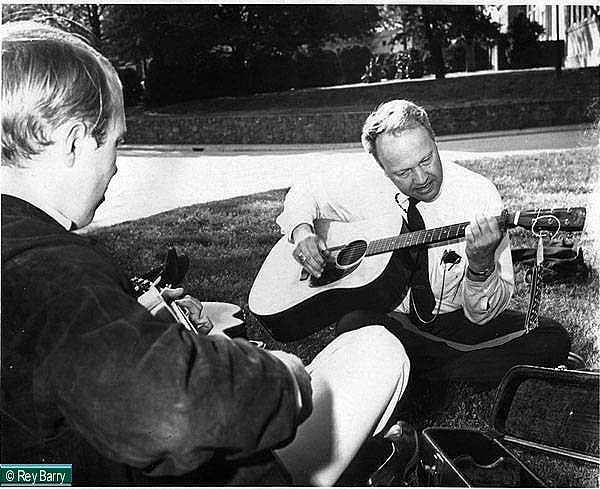
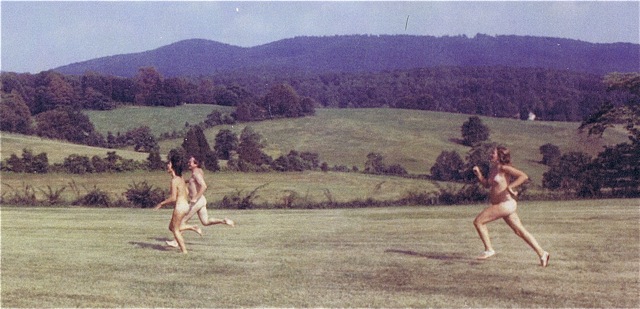
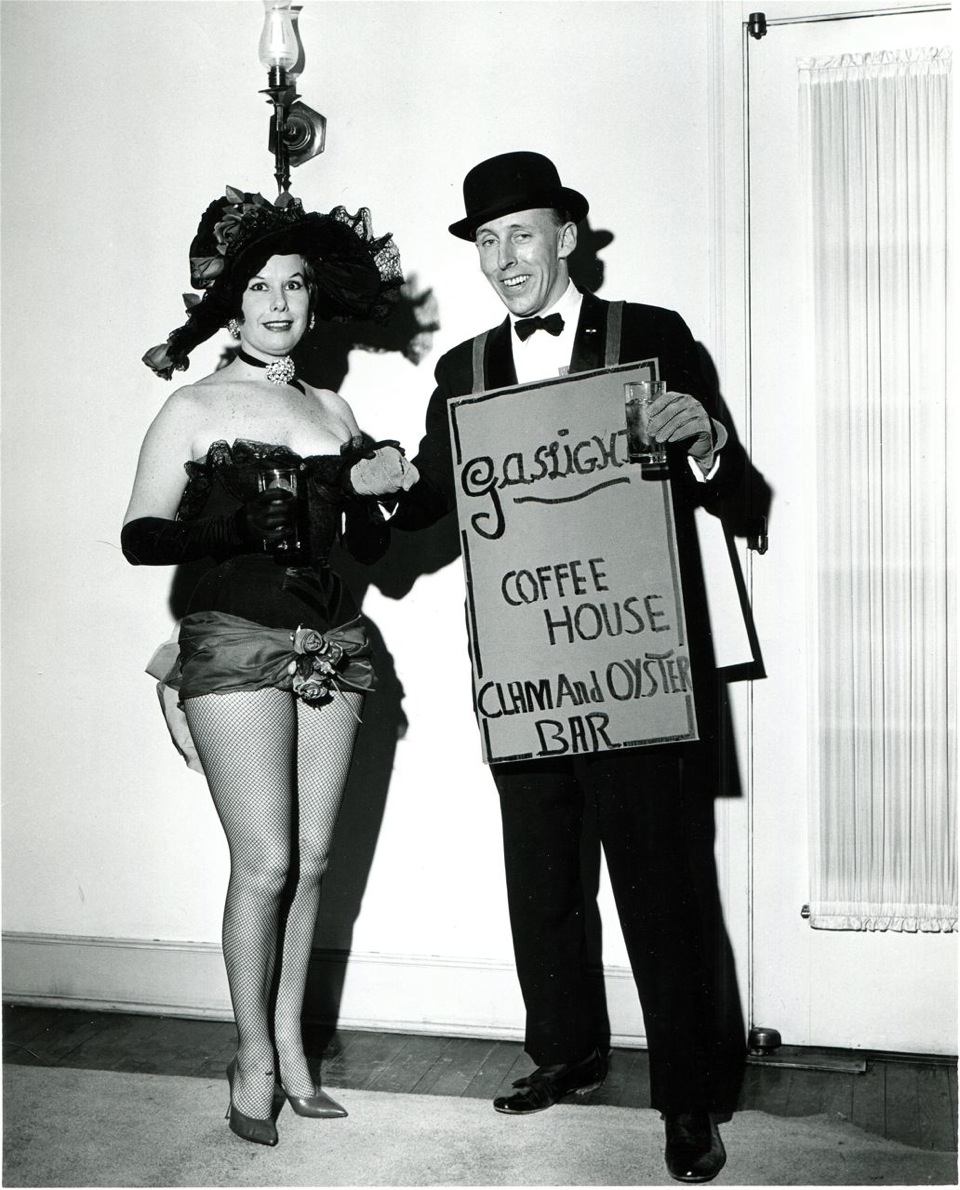
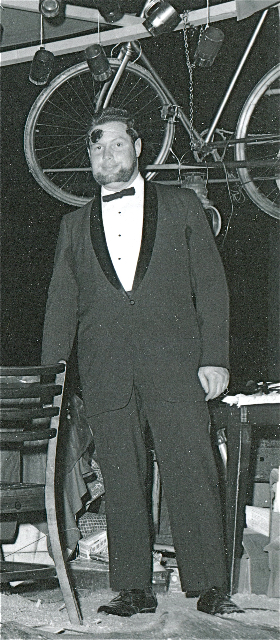 then Robert Johnson [RIP 10/3/2017]
was overseeing waiters Beau Payne, Cuba Anderson, and a half-dozen others.
then Robert Johnson [RIP 10/3/2017]
was overseeing waiters Beau Payne, Cuba Anderson, and a half-dozen others.
